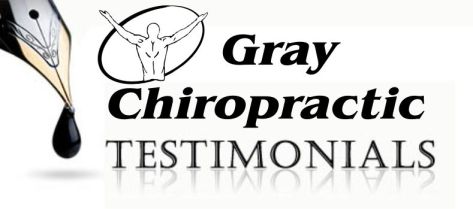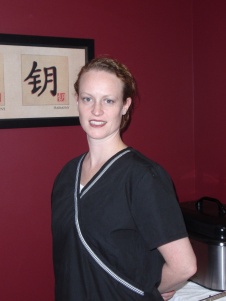 Got a great call this morning that got me to thinking… Backstory: A friend of mine, whose wife has been a patient for a couple years, called and told me, “Ya know… my knee has been killing me for a long time and I never really thought that you might be able to do something about it.” Following this call, I have two conclusions.
Got a great call this morning that got me to thinking… Backstory: A friend of mine, whose wife has been a patient for a couple years, called and told me, “Ya know… my knee has been killing me for a long time and I never really thought that you might be able to do something about it.” Following this call, I have two conclusions.
First, I am grateful that he finally asked. The mere fact that he called meant that he had either been told by someone else that he should ask me, or he finally had a epiphany that he should ask if I could help.
Second, I am concerned that after 118 years, the general public still thinks that chiropractors are just back doctors. Seriously, this gentleman has been a good friend of mine for more than five years. And yet, facing a long-standing and significant condition that was extra-spinal, he hadn’t thought to ask me about it until now.
So, let’s get down to it. “Chiropractic” in it’s derivative form means “done by the hand.” It doesn’t mean done on the back, or done on the neck. Historically, Chiropractic has become known as a method of healing that values and encourages the natural healing ability of the body, and the optimization of the body’s ability to do so. Throughout the past century, our profession has proven time and again that we are capable of treating and improving the health of millions of patients with a myriad of conditions. Plantar Fascitis? Check. Achilles’ Tendinitis? Check. Chondromalacia Patella? Check. Sprained Meniscus? Check. Osgood-Schlatter’s? Check. Hip bursitis? Check. Herniated disk? Check. Menstrual Cramps? Check. Constipation? Check. Irritable Bowel Syndrome? Check. Kidney Stones? Check. Gall Bladder congestion? Check. Difficulty breathing? Check. High Blood Pressure? Check. High Cholesterol? Check. Overweight? Check. Thyroid Dysfunction? Check. Common Cold? Check. Rotator Cuff Tear? Check. Tennis Elbow? Check. Carpal Tunnel Syndrome? Check. Trigger Finger? Check. Torticollis? Check. Cluster Migraine? Check. Tension Headache? Check. …. Shall I go on?
Have all of these conditions been helped and treated by a chiropractic adjustment? Yes and no. If you subscribe to the “straight chiropractor’s” definition of chiropractic, then chiropractors are nothing more than technicians who pop joints. If you subscribe to the “mixer chiropractor’s” definition of chiropractic, then you define the adjustment as the only crucial element to the treatment plan that is assisted by complimenting, external, therapeutic procedures.
However, a realistic definition that complements the true and original derivative “done by the hand,” does not have to explicitly imply that the single most important factor of our care is a physical adjustment. I suggest that a more accurate correlation refers to our ability to take “a hands-on approach.” It is my opinion that, as with all doctors, it is not our actual “hands” or the service we provide that is our most important asset. Our most important asset, and what makes us worthy of being doctors, is our intellect. It is our ability to examine our patients, have a thorough consultation regarding current symptoms and history, and ultimately arrive at a working diagnosis.
Arriving at a working diagnosis allows us to then use our intellect, education, and experience to suggest an appropriate treatment plan. With our knowledge of how the body works, we know the power and outcomes secondary to the chiropractic adjustment, therefore we often incorporate that in our treatment plan. However, we also recommend proper diet, exercise, diagnostic imaging, blood tests, appropriate supplementation, physiotherapy, and rehabilitative therapy. We apply supportive tape or bracing to damaged joints and muscles. We use kinesiotape to improve circulation and minimize further injury. AND, we refer to our health care counterparts when necessary for concurrent and/or more appropriate care.
There is a significant, country-wide push right now for an expanded role for chiropractors in the health care market. For those who wish to go through the additional training and certification, some wish to have the ability to incorporate more traditional Western treatments, such as pharmaceutical intervention. I, for one, don’t have a problem with that. By our very nature and philosophy, the natural and innate power of the human body to heal itself will still be respected. The chiropractic adjustment will still remain a critical therapeutic measure that we can provide to our patients. However, we must not ignore the benefits that can be achieved through the provision of non-traditional methods of treatment. The world is not flat, and sometimes antibiotics are necessary. The Earth is not the center of the Universe, and sometimes muscle relaxants assist in the healing process.
So, in conclusion, chiropractors are not “back doctors.” We are not “neck doctors.” If an individual chiropractor wants to limit his practice to a specialty practice dealing only with backs, or necks, or Carpal Tunnel Syndrome, or headaches, or whatever… more power to ya! However, it is unfortunate that some would seek to pigeon-hole the entire profession to their own desires. It is time to expand our practice models, and provide for our patients regardless of historical traditions. It is time to join the 21st century and encourage the freedom to grow and offer more to our patients. It is time to inform the public that we can treat knees, ankles, ear infections, stomach problems, shoulder injuries, chronic pain conditions, and more. It is time to be the first doctor that comes to mind when ANY health condition presents itself.
– Dr. Gray
 Man, I love what I do! Check this out:
Man, I love what I do! Check this out:

 I received a great question from a patient recently: She had read somewhere that stress and emotions were the cause of back pain, and wondered if I agreed or if it was true. Here is the majority of my answer.
I received a great question from a patient recently: She had read somewhere that stress and emotions were the cause of back pain, and wondered if I agreed or if it was true. Here is the majority of my answer. How many visits does it take to have a well-adjusted spine? It depends on your definition of well-adjusted. For many patients who experience complete pain relief after their first adjustment, the answer might be one. But if you understand you can have a problem even without pain, you’ll see that it takes a lifetime of minor tune-up visits to be at your best. These minor tune-ups also prevent many of the problems that can show up in your 40s and 50s.
How many visits does it take to have a well-adjusted spine? It depends on your definition of well-adjusted. For many patients who experience complete pain relief after their first adjustment, the answer might be one. But if you understand you can have a problem even without pain, you’ll see that it takes a lifetime of minor tune-up visits to be at your best. These minor tune-ups also prevent many of the problems that can show up in your 40s and 50s. There are very few people that if given a choice would decide to have painful surgery or take lots of medication to reduce pain from an injury or disease. For a long time that was the only option open to most of us. With the invention and acceptance of chiropractic medicine, all of that changed. One of the greatest benefits of chiropractic care is its holistic approach to treating the whole body. Most people tend to think of chiropractic medicine as only neck and back adjustments, when it is actually a whole lot more. Chiropractors are trained in many of the sciences and they can do offer help in the areas of neurology, orthopedics, and pediatrics and geriatric care. That means they are ready and able to help patients of any age and fitness level. Here is a quick look at some of the other benefits of chiropractic care.
There are very few people that if given a choice would decide to have painful surgery or take lots of medication to reduce pain from an injury or disease. For a long time that was the only option open to most of us. With the invention and acceptance of chiropractic medicine, all of that changed. One of the greatest benefits of chiropractic care is its holistic approach to treating the whole body. Most people tend to think of chiropractic medicine as only neck and back adjustments, when it is actually a whole lot more. Chiropractors are trained in many of the sciences and they can do offer help in the areas of neurology, orthopedics, and pediatrics and geriatric care. That means they are ready and able to help patients of any age and fitness level. Here is a quick look at some of the other benefits of chiropractic care.
 As chiropractors, our main philosophy is based on finding the cause of problems, rather than focusing on symptoms. Over the last several weeks, I have had the opportunity to speak with several professional athletes about many different subjects. One subject during our conversations was in reference to the type of exercise they do during the off-season to stay physically fit. One expressed that he liked to play tennis. He said he would rather play tennis for two hours than ride a stationary bike for 30 minutes. At this point, I started to think about what motivates a person to want to stay physically fit. In the case of a professional athlete, it might be the possibility of making millions of dollars for as long as they are able. That might be one reason. But what about the average person? What is the average person’s motivation to exercise?
As chiropractors, our main philosophy is based on finding the cause of problems, rather than focusing on symptoms. Over the last several weeks, I have had the opportunity to speak with several professional athletes about many different subjects. One subject during our conversations was in reference to the type of exercise they do during the off-season to stay physically fit. One expressed that he liked to play tennis. He said he would rather play tennis for two hours than ride a stationary bike for 30 minutes. At this point, I started to think about what motivates a person to want to stay physically fit. In the case of a professional athlete, it might be the possibility of making millions of dollars for as long as they are able. That might be one reason. But what about the average person? What is the average person’s motivation to exercise?